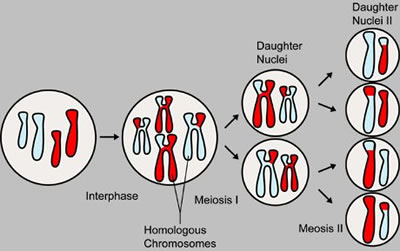Meiosis is the method by which gametes - sex cells: sperm, eggs and pollen - are created.
It takes place inside eukaryotic cells (cells with nuclei) that undergo sexual reproduction.
Meiosis differs from mitosis, which is a form of asexual reproduction in which cells divide to form identical daughter cells.
 In meiosis, the new cells that are created contain only half the number of chromosomes as the original cell. These new cells are known as haploid cells.
In meiosis, the new cells that are created contain only half the number of chromosomes as the original cell. These new cells are known as haploid cells.
This is unike mitosis, where the new cells contain the same number of chromosomes as the original cells. These new cells are called diploid cells.
Stages of Meiosis
Cells which engage in meiosis undergo a preparatory phase, known as interphase I. It is similar to the interphase of cells that undergo mitosis.
The chromosomes in a cell are replicated during interphase I, before the cell enters meiosis.
Therefore, when the cell enters meiosis, it has twice the original amount of DNA.
Meiosis itself is divided into two stages - meiosis I and meiosis II.
In meiosis I, two daughter cells, with the same number of chromosomes as the parent cell (before replication) are created.
In meiosis II, these daughter cells divide in half (so the daughter cells are now parent cells), creating four new daughter cells each with half the original number of chromosomes.
Meiosis I and meiosis II are divided by a second interphase.
The phases which make up meiosis I and meiosis II are similar to the phases of mitosis.
Meiosis I
Prophase I
Prophase I is divided into five stages: leptonema, zygonema, pachynema, diplonema and diakinesis.
Leptonema (leptotene stage)
Chromatin (a substance containing DNA and protein) begin to coil and condense to form chromosomes.
Zygonema (zygotene stage)
Sister chromatids (identical chromosomes that were created by replication during interphase) begin lining up side by side.
Each pair of chromatids makes up a chromosome.
Homologous chromosomes start coming toward each other.
(Homologous chromosomes are chromosomes which have genes for the same feature in the same location. For example, one of a pair of homologous chromosomes may have a gene for red hair in the spot where the other chromosome in the pair has a gene for brown hair.)
Pachynema (pachytene stage)
In a process known as synapsis, aligned homologous chromosomes (each consisting of a pair of sister chromatids) come together.
The pair of chromosomes that has undergone synapsis is known as tetrad because it contains four chromatids. A tetrad is also sometimes called a bivalent.
These chromosomes may undergo a process known as crossing over, during which there is an exchange of genetic material between homologous chromosomes. This happens because chromatids break and parts of them become reattached to other chromosomes.
Crossing over is essential for maintaining genetic variation within a species.
Diplonema (diplotene stage)
Sister chromatids and homologous chromosomes begin to separate.
However, they do not separate completely.
Diakinesis
The nuclear membrane (nuclear envelope) disappears.
Chromosomes are condensed as much as possible. All four chromatids in the tetrad (bivalent) are clearly visible through an electron microscope.
Metaphase I
A spindle, similar to the spindle formed during mitosis, attaches to the chromatids and causes them to line up along the cell's equatorial plane.
Anaphase I
The microtubules of the spindle shorten, pulling homologous chromosomes toward the opposite ends (poles) of the cell
However, each pair of sister chromatids remains joined together.
Telophase I
The chromosomes have moved to the opposite cell poles. They decondense and uncoil.
A new nuclear membrane forms around each chromosome.
Cytokinesis, or cell division, takes place, so that two daughter cells form.
Interphase II
Interphase II is similar to Interphase I, except no chromosome replication takes place.
Meiosis II
Prophase II
Chromatids shorten and thicken. The nuclear membrane disappears.
Metaphase II
A new spindle attaches to the chromosomes.
Anaphase II
The sister chromatids, now known as sister chromosomes, move to opposite ends of the poles.
Telophase II
Chromosomes lengthen and uncoil.
A new nuclear membrane forms around each sister chromosome.
Cytokinesis takes place, producing four daughter cells, each with half the number of chromosomes as the original cell.